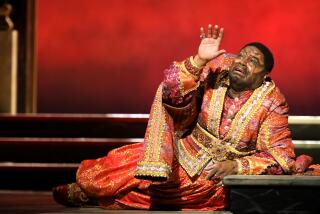Music review: Gabriel Kahane’s score is conducted by his father
Gabriel Kahane, best known as an indie singer-songwriter, was his own charismatic singer-songwriter Saturday night in the West Coast premiere of his affecting “Crane Palimpsest” at the Alex Theatre.
As he does in a club, he used a microphone and wore jeans. He accompanied himself on guitar and piano. He also had the Los Angeles Chamber Orchestra on hand, and he gratefully used everything at his disposal to merge pop and new music sensibilities naturally and unpretentiously.
Composer-performers who write orchestral pieces for themselves as soloists can these days be anything they like. Bringing an electric guitar on stage or even DJing along with an orchestra is hardly eccentric. As for mixing styles, that’s been going on a lot longer than any of us have been around.
So what was perhaps most unusual about “Crane Palimpsest,” part of the final program in Jeffrey Kahane’s 15th season as LACO music director, is that the score was conducted by the composer’s father. The circumstance, at least since Leopold Mozart exploited his protégé son, is typically the other way around. Siegfried Wagner conducted his old man’s “Ring,” and Maxim Shostakovich is an interpreter of his father’s symphonies.
In the concert prelude Saturday, father and son demonstrated a warm and amusing rapport.
“It’s good to see you, you look good.”
“Thanks, Dad, can I borrow some money?”
In fact, something significant was going on. This was the first time the 55-year-old Kahane had conducted the music of the 30-year-old Kahane, who has made it his business to go his own way musically, staking out a career as a new music and pop music maverick in Brooklyn. But it may not be all that easy to rebel against a supportive conductor-pianist father who is open to a variety of musics and who called his son one of his musical heroes.
Moreover, the younger Kahane has been attracting increasing attention from the establishment lately. “Crane Palimpsest” is a co-commission with the American Composer’s Orchestra and had its premiere at Carnegie Hall last month. Next month, a musical Kahane has scored, “February House,” opens at the Public Theatre in New York.
Brooklyn is very much on the composer’s mind. “February House,” about which there is considerable buzz, concerns the Brooklyn house in which Benjamin Britten, W.H. Auden, Paul Bowles and Gypsy Rose Lee lived together during World War II. “Crane Palimpsest,” meanwhile, is an ode to the Brooklyn Bridge.
Building on the idea of a palimpsest, or a document on which new texts are written over old ones, Kahane draws from Hart Crane’s poem “The Bridge” and his own lyrics. Throughout the 22-minute score, though, musical styles tend not to merge but graciously flow one into the next. The orchestra writing is atmospheric, favoring color (particularly with percussion) and eerie strings. Kahane’s singing style can be pop-flavored with his own emotion-worn-on-the-sleeve lyrics and more coolly classical for Crane’s intricate stanzas.
Each of the work’s four sections begins with Crane and moves on to Kahane. Opening with the great poet’s dawns, seagull’s wings, chained bay waters, apparitional sails and dropping elevators, Kahane sets a somber scene, his vocal line a little like John Adams with friendlier interval leaps. In the second section, Gypsy Rose Lee makes a sort of entrance in a Kahane song (“BMT”) about the subway with a snappy Bernstein flavor.
The emotional climax is a rapturous Kahane ballad, “The Navy Yard,” sung at the piano. Strings in the orchestra slide up and down like one of Crane’s elevators defying gravity. A danger of pop sentiment is sentimentality; there is a hint of that at the end. And for all its surface interest, the orchestral writing could sound at times unfinished.
Still, this is a young composer with a voice, staking out his own territory.And it held its own surrounded by two palimpsestic masterpieces. Kahane the conductor set up “Crane Palimpsest” with Ives’ “Three Places in New England,” a classic layering many kinds of Americana. Surprisingly, this was the evening’s other first, the score never having been played in LACO’s 44-year history. It got a clean, illuminating performance. Not every inner part came through (the piano and pianissimo strings sometimes disappeared), but there was no smudging of details.
Haydn’s Symphony No. 104, an old favorite of this orchestra, concludes with a Croatian folk song Haydn heard on the streets of London. Kahane, no doubt elated from his son’s success, conducted with irrepressible spirit.
RELATED:
Legal spat surfaces between Thomas Kinkade’s wife, girlfriend
Blair Underwood in ‘Streetcar’: What did the critics think?
USC School of Theatre to change name to School of Dramatic Arts
More to Read
The biggest entertainment stories
Get our big stories about Hollywood, film, television, music, arts, culture and more right in your inbox as soon as they publish.
You may occasionally receive promotional content from the Los Angeles Times.







